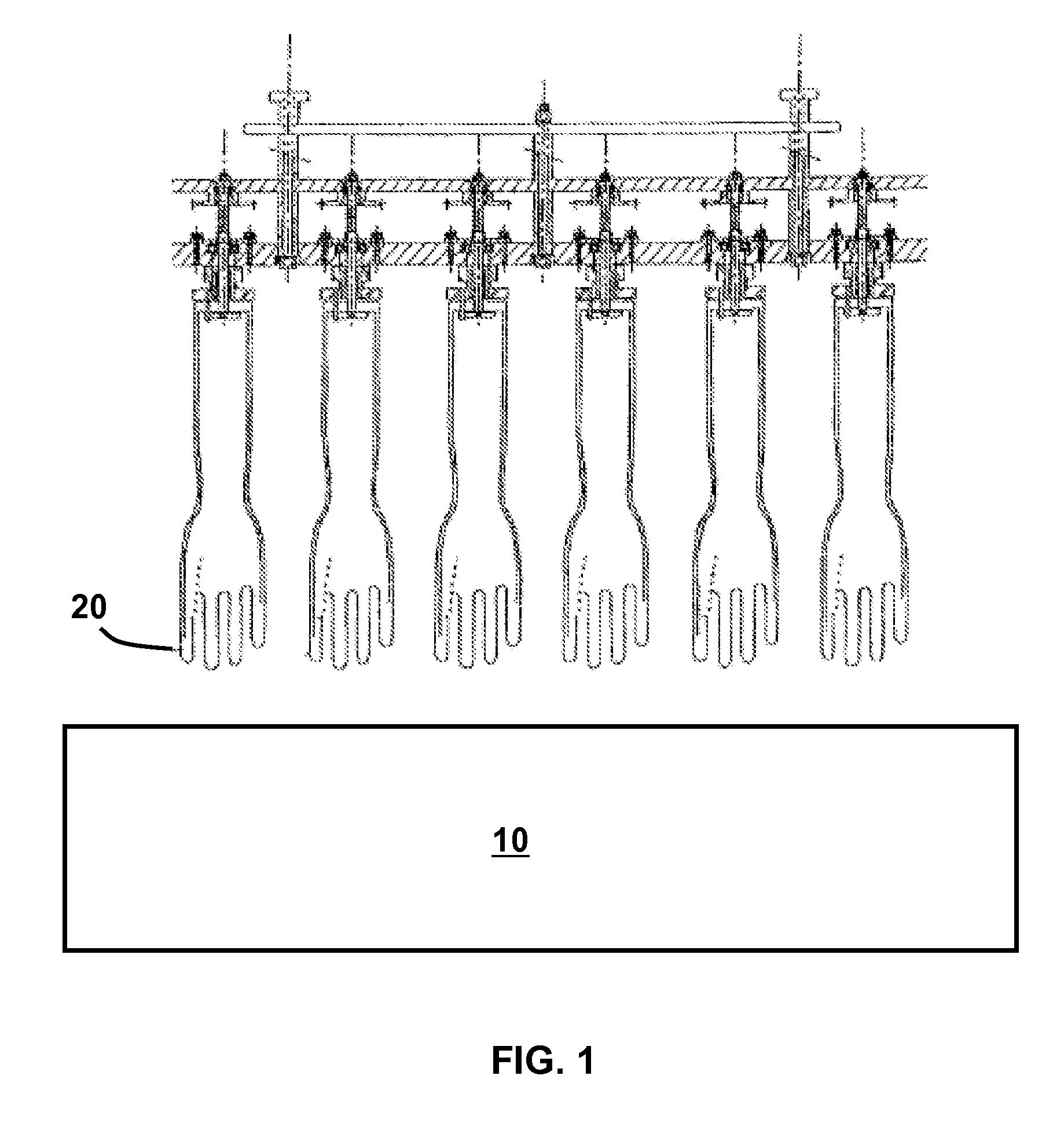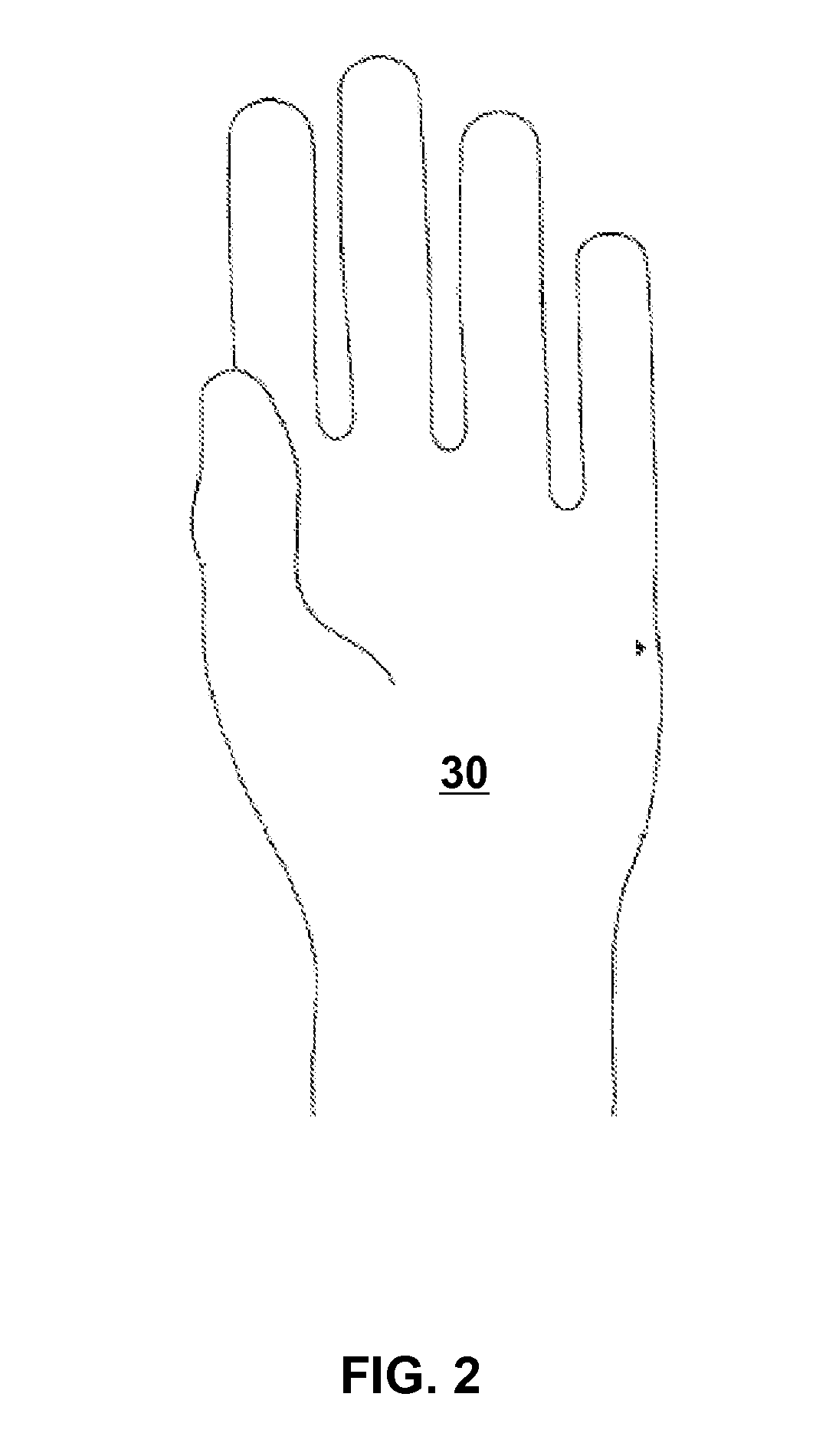Thermochromic elastic articles
a technology of elastic articles and articles, applied in the field of thermochromic elastic articles, can solve the problems of undesirable additional cost of such a post-treatment step, color flaws on the surface, undesirable lack of resiliency and durability,
- Summary
- Abstract
- Description
- Claims
- Application Information
AI Technical Summary
Problems solved by technology
Method used
Image
Examples
example 1
[0042] As a specific example of an embodiment of the foregoing, a temperature responsive elastic color changing article was produced as follows. First, a base latex compounding emulsion was produced using Synthomer in deionized water. Synthomer is a nitrile rubber latex, specifically a carboxylated butadiene-acrylonitrile rubber latex, available from Synthomer Ltd. of Harlow, Great Britain. The base latex compounding emulsion additionally included about 1 weight percent ammonia, about 2 weight percent curing / crosslinking agent, and about 1 weight percent kaolin clay as a filler and opacifier.
[0043] For Example 1, 3 grams of red thermochromic pigment powder and 3 grams of blue thermochromic pigment powder, both available from Color Change Corporation, Streamwood, Ill., were mixed together in their powdered form to produce 6 grams of a purple colored powder. The color transition temperature of each pigment was 31 degrees Celsius. Next, 2.5 grams of the mixed purple powder was added t...
example 2
[0046] For Example 2, two thermochromic pigment aqueous-based inks, magenta and blue, were obtained from Matsui International of Gardena, Calif. The color transition temperature of each pigmented ink was 31 degrees Celsius. 40 grams of the magenta ink was mixed with 6 grams of the blue ink, to form a purple colored ink. Next, 2.5 grams of the purple colored ink was added to 250 milliliters of the latex compounding emulsion (described above with respect to Example 1) and mixed together by stirring to form a latex compounding emulsion having about 1 weight percent of the thermochromic pigment ingredient.
[0047] Next, another cylinder-shaped former was heated to 90 degrees Celsius and dipped into the pigment-containing latex compounding emulsion to coat the former. The former was placed into an oven heated at 90 degrees Celsius to cure for a 10 minute period. When removed from the oven, the thermochromic elastic article coated onto the former was essentially colorless, but upon cooling...
example 3
[0048] For Example 3, the concentration of the thermochromic pigment ingredient was increased in order to enhance the color intensity of the thermochromic elastic article and to increase the contrast between the initial and de-colorized state of the thermochromic elastic article. For Example 3, the same mixture of the two thermochromic pigment aqueous-based inks (mixture of magenta and blue thermochromic pigment inks) was used, except that 10.5 grams of the inks mixture was added to 450 milliliters of the latex compounding emulsion (described above with respect to Example 1) and mixed together by stirring to form a latex compounding emulsion having about 2.3 weight percent of the thermochromic pigment ingredient. Next, another former (for Example 3, a hand-shaped former) was heated to 90 degrees Celsius and dipped into the pigment-containing latex compounding emulsion to coat the hand-shaped former. The former was placed into an oven heated at 90 degrees Celsius to cure for a 10 min...
PUM
| Property | Measurement | Unit |
|---|---|---|
| transition temperature | aaaaa | aaaaa |
| transition temperature | aaaaa | aaaaa |
| transition temperature | aaaaa | aaaaa |
Abstract
Description
Claims
Application Information
 Login to View More
Login to View More - R&D
- Intellectual Property
- Life Sciences
- Materials
- Tech Scout
- Unparalleled Data Quality
- Higher Quality Content
- 60% Fewer Hallucinations
Browse by: Latest US Patents, China's latest patents, Technical Efficacy Thesaurus, Application Domain, Technology Topic, Popular Technical Reports.
© 2025 PatSnap. All rights reserved.Legal|Privacy policy|Modern Slavery Act Transparency Statement|Sitemap|About US| Contact US: help@patsnap.com


